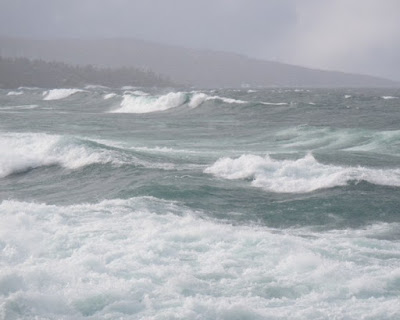November is a conjurer.
The word itself is mystical. Feel the name of our 11th month roll
around the tongue and an immediate sense of grey, and perhaps grief, massages the
thoughts. Remembrance Day, with its images of poppied graves and Lightfoot’s haunted
song about the Edmund Fitzgerald enhances the somber mood even more.
But this November is a
bit different. It must be the past few glory days of warmth and sunshine. Waves
wash cracked cliffs with a lacy spray. And Lake Superior’s power almost seems
delicate against the shimmering golden threads of hilltop grasses. The days are
precious. You have to rush outside and hug them; hold on tight to something that
you know soon will be going.
I’ve been enjoying this
November gold by hiking along the bronzed grey trails where leafless trees allow
a peek into an otherwise hidden forest world. The magic is everywhere. Even on
one of the wet days, when I had to admire the outside from behind rain
splattered glass, I found treasure. A yellowed, 60-year-old Sault Star
newspaper clipping emerged from one of my paper files. The May 28, 1955 article,
written by a Pat McColl, featured interviews with three men who remembered November
1913.That’s when the “worst storm” in Great Lakes recorded history took the lives
of 250 people.
In the article, a
Captain Raeburn from the Michigan Sault said, “All of a sudden Lake Huron
seemed to back into the North Channel. My room aboard ship had a foot of snow
in it but at that we fared better than hundreds that night.”
A second man, Sault
Harbourmaster Frank Parr added his memory of the storm. “I was a passenger
aboard the Winona going to Marquette Michigan. In 36 hours we made a distance
of eight miles!” he said. “Needless to say I returned by rail.”
The third interview was
with the Sault’s Captain J.W. Alexander. 1913 was Alexander’s first year of
sailing on Lake Superior. Only 16 at the time, he was wheelsman aboard the ACR
ship the Thomas J. Drummond which was
carrying rails to Thunder Bay. That night Lake Superior showed him power that
few will ever witness.
“It was the night of
November 11,” he said, “and that gale really was the worst ever. Our ship
passed the (ship) Palaki off
Whitefish Point and I guess we were the last to see her.”
After that gale diminished,
people spoke of it as “The Big Blow”, “The Freshwater Fury” or “The White
Hurricane”. The storm lasted a long time, whipping up four of the five Great Lakes
from November 7 to the 10th. In fact it, was an extratropical
cyclone, the result of a collision between two major fronts. Winds gusted to
145 km, waves rose to 11m and snow squalls reduced visibility to near zero. The
storm’s deceptive lulls heightened the anxiety. Just as sailors thought the
worst was over, the fury raged back again. By the time it was done, besides the
loss of 250 people, the storm destroyed 19 ships and stranded 19 others. Two
ships, the Leafield and the Henry B Smith, went down in Lake
Superior. The Leafield, with a loss
of 18 lives, broke up on a shoal off Angus Island near Thunder Cape, Ontario.
The Henry B. Smith, along with 25
crewmen, sunk off of Marquette Michigan.
Captain Alexander
stayed with the Drummond until 1915
when he enlisted in the army because Canada did not have a navy at the time.
After World War One, he sailed on Abitibi tugs and then joined the Royal
Canadian Navy from 1940 until 1945. After World War Two, Alexander returned to
the Sault to become Marine Superintendent for the Abitibi. The Thomas J. Drummond had her own fate. She
went to Canada’s eastern shore to deliver coal from Nova Scotia to Newfoundland.
But an October 30, 1937 Atlantic storm took the Drummond. She and her crew left Sydney and were never seen again.

Losses from the storm
of 1913, the Great Wars or the sinking of the Fitzgerald are embedded into our
culture. We remember the tragedies as best we can. We lay wreaths, wear
poppies, light fires and cherish bagpipes, hymns and ballads. It's how we grieve. The memories from those who knew such difficult times are a
gift, a reminder that humanity can be calm, reflective and gentle...like the
soft light of a fine November day.
May 28, 1955 newspaper clipping.



